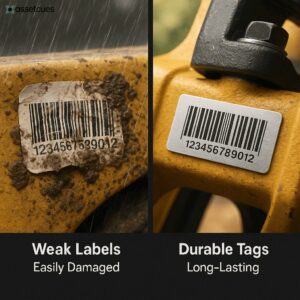Introduction
So, how much time do crews actually waste searching for missing tools? The answer can be shocking, as employees might spend nearly an hour daily locating misplaced equipment, creating costly downtime. However, a tool tracking barcode system solves this problem by labeling each tool with a unique code and logging every check-out and return.
Moreover, it ensures real-time visibility, showing exactly who has a tool and where it is. No more ghost assets or endless searches — barcode tracking brings order, and you can explore more in this barcode asset tracking guide.
Why Use a Barcode System for Tool & Equipment Tracking?
Barcode tool tracking is all about accountability and efficiency. It replaces unreliable manual logs with quick scans that update a shared database. That means fewer lost tools, less time spent searching, and more accurate inventory counts.
- Accountability & Loss Prevention: Every tool scan links the item to a person or job, discouraging “hoarding” and theft.
- Efficiency & Time Savings: Scanning a barcode takes seconds, so workers spend less time hunting for tools.
- Inventory Accuracy: Automated updates keep the tool list current and error-free, eliminating ghost assets.
- Cost Savings: Fewer missing tools mean fewer replacements to buy and fewer project delays waiting on equipment.

Key Components of a Tool Tracking Barcode System
A successful barcode tracking setup has several key parts working together. Durable labels on each tool, convenient scanning devices, and robust software all play important roles.
-
Barcode Labels & Tags – Durability Matters
Each tool needs a durable barcode label that stays put. Choose weatherproof tag materials to keep barcodes scannable despite harsh conditions. For example, laminated polyester stickers work well indoors, while anodized metal plates endure outdoor use on heavy gear. Attach labels securely in a protected spot to prevent wear or peeling.
-
Scanners and Mobile Devices
Tools can be scanned with a smartphone app or with dedicated barcode scanners. Smartphones are convenient on job sites. Rugged handheld scanners are better for high-volume or long-range scanning in a warehouse. You can even set up a fixed scanning station for a tool crib if needed.
-
Software & Database System
At the core, asset tracking software serves as the system’s central database. It updates in real time, showing who holds each tool and where. Moreover, it provides a user-friendly interface, cloud access, and insightful reports. Additionally, strong software integrates with ERP systems while enforcing permissions for high-value items.
Implementing Barcode Tracking in Your Operations
Rolling out a new barcode tool tracking system takes planning and good habits. Here’s how to implement it step by step to ensure success:
Step-by-Step – How to Track Tools and Equipment with Barcodes
- Inventory Your Tools: Create a list of all tools and equipment, along with key details for each item.
- Tag Tools with Barcodes: Decide on a barcode format (1D or QR) and use durable labels that will withstand each tool’s environment. Affix a unique barcode tag to every tool in a low-wear spot.
- Set Up Software & Procedures: Import your inventory into asset tracking software and configure it for your operations. Then establish a standard process for check-outs and returns. For example, require scanning each tool to a person or job when issued, and scanning it again upon return. Ensure there’s a simple backup method for cases when a barcode can’t be scanned.
- Train Your Team: Teach employees how to use the scanning app or device and stress the importance of scanning every time a tool changes hands. Provide hands-on practice so everyone is comfortable, and make the new process part of daily routines.
- Audit Regularly & Improve: Do periodic audits (e.g. monthly) by scanning all tools to verify that records match reality. Immediately replace any missing or damaged labels. Use the data to spot issues (like tools that often go missing) and address them with targeted fixes or extra training.

Have Questions About Asset Tracking?
With 10+ years of hands-on experience, our team offers practical, industry-specific advice.

Have Questions About Asset Tracking?
With 10+ years of hands-on experience, our team offers practical, industry-specific advice.
Best Practices and Tips for Success
Ensuring long-term success with a barcode tracking system means making it part of everyday work. Keep these best practices in mind:
-
Make It Culture:
Therefore, make scanning tools a normal and consistent part of the job. Additionally, get management on board and assign a “barcode champion” to encourage scanning. Moreover, share successes such as fewer lost tools to keep teams motivated.
-
Continuously Improve:
Regularly review your tracking data and adjust the process to fix weak spots. If certain tools aren’t being scanned or one site has more losses, find out why and take action – whether it’s refresher training or better label placement.
Ensuring Barcode Labels Survive the Field
Yes, you can track outdoor equipment with barcodes using durable tags. Field conditions are harsh, so invest in industrial-grade tags resisting UV and heat. For example, anodized aluminum plates or laminated decals withstand rain, mud, and sunlight. Secure tags on clean surfaces and check regularly during scheduled maintenance. With durable tagging and proper care, barcode systems reliably manage even heavy equipment.

Real-World Use Cases by Industry
Different industries use barcode tracking in their own way, but all see big benefits in controlling tool inventory. Here are a few examples:
-
Construction & Field Projects
Construction companies used to lose many tools to theft or mix-ups across job sites. By tagging every tool and requiring a quick scan whenever one is taken or returned, they dramatically cut losses. Accountability improved too, since unreturned tools are immediately flagged. One contractor saw missing tool incidents drop to nearly zero, saving thousands on replacements and preventing work delays.
-
Manufacturing & Plant Maintenance
Maintenance teams in factories share specialized tools that can easily go missing. After introducing a barcode equipment tracking system, one plant achieved near-100% tool accountability. Missing tools no longer cause production delays because anyone can quickly see who last used an item. Audits that once took days are now done in minutes with quick scans. Management also identified rarely used tools and avoided buying unnecessary duplicates.
-
Facilities Maintenance & Field Service
Field service technicians move tools between trucks and job sites, which makes it easy to misplace items. A regional maintenance company had each tech scan tools as they loaded up their van each morning. They also scanned each item again when returning it in the evening. This change led to a 30% drop in tool replacement costs. Technicians now spend far less time searching for or retrieving forgotten equipment.
-
Streamlining Tool Tracking with AssetCues
AssetCues is an all-in-one platform that therefore simplifies barcode system rollouts effectively. It enables label printing, mobile scanning (even offline), and instantly updates data in the cloud. Moreover, the software supports check-in/check-out workflows, provides insightful reports, and integrates with enterprise systems. Consequently, with this proven solution, you gain a secure system without building from scratch.
FAQ (Frequently Asked Questions)
Q: How do I track tools and equipment with barcodes?
A: Start by labeling every tool or equipment piece with a unique barcode. Then, use a scanning device connected to asset tracking software for updates. Each scan records who has the tool and its current location. The central database updates instantly, showing usage history and present location. By consistently scanning tools, you maintain a real-time log preventing equipment loss.
Q: Barcode tool tracking vs. RFID – which is better?
A: Both technologies track assets, but barcodes remain the preferred choice for tool tracking. They are cheaper and simpler, with labels costing pennies and easy smartphone scanning. RFID tags scan multiple items without line-of-sight but face higher costs. Additionally, RFID signals struggle around metal, limiting effectiveness in some environments. Therefore, barcodes provide the best ROI and ease for most inventories.
Understand how barcode, RFID, and GPS differ in asset tracking>>
Upgrade Your Asset Tracking with AI & Barcodes
See how our solution simplifies end-to-end asset management using barcodes, mobile, and AI.
Upgrade Your Asset Tracking with AI & Barcodes
See how our solution simplifies end-to-end asset management using barcodes, mobile, and AI.
Conclusion & Next Steps
Adopting a barcode tool tracking system brings order and visibility to operations. Tagging tools and logging handoffs significantly reduces equipment loss and downtime issues. Consistency matters, so plan carefully, train teams, and encourage regular scanning.
Starting with a pilot program helps build confidence for full implementation. Over time, this small effort delivers huge returns with fewer headaches. In fact, the rising adoption of barcode solutions is reflected in the growing barcode software market, showing how businesses across industries are recognizing its value.
About Author






